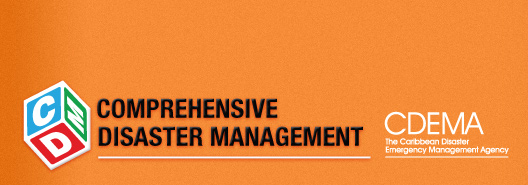
| Caribbean Vulnerability |
|
What is vulnerability? These are the conditions determined by physical, social, economic, and environmental factors which can increase the likelihood of a community being negatively impacted by a hazard. Why are we vulnerable? Any type of disaster can have a terrible impact on many different parts of our lives. When emergencies happen, they damage our countries’ economies, cause injuries, sickness and death as well as destroy the environment. In the Caribbean, because our islands are so small, even a little hazard can create a lot of destruction – and when a real catastrophe does happen, the damage to our islands can affect us for decades. Although more developed countries may have to spend more money to rebuild after a natural disaster because they are bigger – our economies are smaller so the percentage of money lost is much more in our smaller countries. Hazards are unavoidable because of our location but the effects disasters are made worse because of our fragile, developing economies. They harm our tourism and agriculture industries which hurt our countries’ ability to make money. Disasters and the Economy The direct effects of disasters include the damage to property, businesses and infrastructure. Money must be spent to repair this damage before the country can return to normal. Governments often have to take money away from other projects to cover the costs. Additionally, depending on how long it takes to return to normal, the country can lose money from the break in production and services. Such losses are hard for any country to manage but for a developing economy, it can be devastating. All of this causes the economy growth to decrease. An island may have to borrow money just to get by – which adds to the debt burden. History
Disasters and our Industries Our history shows that there is a definite link between the region’s vulnerability to disasters and sustainable development. Tourism Tourism is the world’s largest industry and the Caribbean depends almost entirely on tourism for foreign exchange. This is a fact that makes us one of the most tourism dependent areas in the world. Tourism is a very broad category that includes many other sectors. For example, people in the agriculture industry get jobs when hotels and restaurants buy their produce. Persons who drive taxis and buses make their money by carrying tourists around the islands. Many persons in the Caribbean are employed directly or indirectly through tourism. This means that when the tourism industry topples, it causes a domino effect that makes other industries fall down behind it. The tourism industry is probably the most vulnerable to disasters. Tourists travel to our region because of the sunshine, sea and sand we advertise, because of this, many hotels and businesses which target tourists are built very near to the coast. Unfortunately, many hazards, like hurricanes, storm surges and tsunamis are also much worse closer to the shoreline. Additionally, because tourism is dependent on so many other sectors when these other parts are damaged, it does negatively affect the industry. Also many of these buildings which are so near to the coast worsen the damage from hazards because of the pollution they send off into the water. Although countries know this, nothing is really done to stop the construction of these buildings so close to potential hazards. For example, in the island territory of Barbados, there about 420 places of accommodation divided between hotels, villas and condominiums and about 90 percent are located on the coastline. When disasters do happen and these places are damaged, they are just rebuilt instead of creating mitigation measures. Agriculture More than 70% of the world’s land is used for agriculture. In the Caribbean it is one of the largest creators of jobs and it generates a lot of money from export. In 2009, agriculture accounted for almost 5% of Gross Domestic Product in the Caribbean, varying from 1% in several island nations to 20% or more in countries such as Haiti and Guyana. The agriculture industry depends on the weather. Therefore, it is easily impacted by disasters. Too much or too little rain can cause crops to die while livestock can be killed during earthquakes and landslides. It takes time before both crops and livestock can reach maturity again. This means that for months at a time, this industry can be at a virtual standstill. An island may depend on the agriculture industry for its own produce, which can mean that once the crops and animals are destroyed during a disaster, there may become a shortage which would cause the price of these goods to go up. Also, in certain cases, the island may have to import produce, which could be costly as well. From 1988 to 2006, it is estimated that damages from disasters in the region’s agriculture sector resulted in economic losses totalling almost US$35 million a year. Health Disasters can also impact the population’s health. Damage to the health sector comes from illnesses, death and losses or disruption to the health industry. Of course, the most serious of all these problems is the loss of life. Most deaths after a disaster come from health related problems, for example, infected wounds and transmitted diseases. These usually affect the country’s most vulnerable persons, such as the poor, young and the elderly. During and after a disaster, you may be injured from falling debris or from some other unavoidable effect of a disaster. For example, during a volcanic eruption, falling ash causes respiratory problems and irritation once it gets into the eyes or mouth. There may also be more cases of diarrhoea, respiratory diseases and skin problems after an emergency, depending on what the population was exposed to. If sewage or water systems are destroyed during a disaster, people can become sick from water borne diseases. Also, heavy rains and lingering debris can lead to the spread of rodents and mosquitoes which carry disease. When disasters damage the agriculture industry and food becomes contaminated, people can become sick after eating it. When a lot of people suddenly need to get medical attention at the same time, it puts a strain on the country’s resources. Money is also lost during the disaster if a clinic, hospital or any of the facilities or the machines inside, should be destroyed or damaged. Infrastructure When we speak about the vulnerability of infrastructure, we mean how susceptible it is to the effects of disasters. Infrastructure refers to structures which are essential to the operation of a country – for example, ports, roads, schools and government buildings. Obviously when these things are damaged or destroyed, money must be spent to fix them since they are so important to the functioning of the country. The time when they aren’t working causes the nation money, especially in the case of the ports which many countries rely on for the tourism industry. If roads or blocked or buildings are unsafe, persons cannot go to work and so, productivity decreases. In developing countries, it is estimated that about 95% of infrastructure is government owned and government has the responsibility of rebuilding it after a disaster. Many times, the money spent to reconstruct is more than the cost of mitigation. Money that could be used to develop the nation must now be used somewhere else and as a result, the country suffers. How can vulnerability be reduced? You can reduce vulnerability through preparation. Our region is particularly vulnerable because of our location, our status as developing nations and our heavy dependency on particular sectors for foreign exchange. In the Caribbean, many of our disaster preparation practices are flawed. We wait until the last hour before we begin to prepare. We would also prefer to hope that a disaster never happens than get ready for one. This type of thinking must be replaced with a culture of preparedness. Caribbean people must realise that there is not a question of if a disaster may happen, there is only when. Preparation can make a world of difference. |
|
Looking for:
|











